Desert ecosystems, characterized by extreme temperatures and limited water supply, host an astonishing diversity of flora uniquely adapted to survive under harsh conditions. From iconic cacti to vibrant blooming plants, these hardy species not only survive—they thrive. This exploration highlights some of the most fascinating desert plants and flowers, illustrating their adaptations and significance in their ecosystems.
Prickly Pear Cactus (Opuntia)
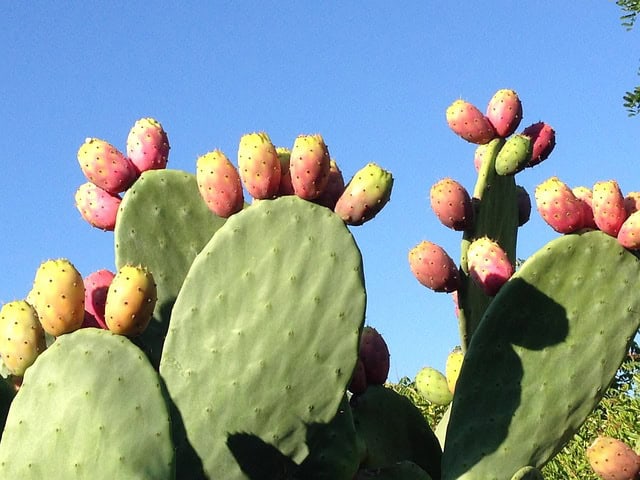
The Prickly Pear Cactus, scientifically known as Opuntia, boasts both beauty and utility. This iconic plant features flat, paddle-like pads covered with spines, which act as a defense mechanism against herbivores. Apart from its impressive physical structure, the Prickly Pear produces vivid flowers that bloom in an array of colors, including yellow, red, and purple. The pads and fruits, known as tunas, are edible and are used in various culinary dishes, especially in Mexican cuisine. In addition to being a food source, the cactus plays a crucial role in its ecosystem by providing habitat and nourishment for a variety of wildlife, including birds and insects.
The Joshua Tree (Yucca brevifolia)

Renowned for its distinct silhouette, the Joshua Tree is a member of the Agave family and primarily found in the Mojave Desert. Yucca brevifolia features long, spiky leaves that rise from the trunk, creating a striking appearance reminiscent of a surrealist landscape. These trees bloom with large clusters of white flowers, typically between March and April. The Joshua Tree’s unique reproductive relationship with the Yucca moth ensures pollination, further enhancing its ecological significance. Beyond its beauty, this species serves as a habitat for many desert-dwelling creatures, including woodpeckers and various insects.
Curve Leaf Yucca (Yucca gloriosa var. tristis)
Known for its graceful, arching leaves, the Curve Leaf Yucca presents a stunning addition to the desert landscape. This variegated species thrives in sandy soils and displays a striking rosette of long, rigid leaves that creates a dramatic focal point in gardens. In late summer, it produces tall flower spikes adorned with creamy white, bell-shaped blooms that attract pollinators. The Curve Leaf Yucca can withstand drought and poor soils, showcasing its evolutionary adaptations. Furthermore, it serves as a protective cover for smaller animals in the harsh desert climate.
Golden Barrel Cactus (Echinocactus grusonii)

The Golden Barrel Cactus, or Echinocactus grusonii, is lauded for its barrel-shaped, ribbed body adorned with golden spines. This iconic species commonly grows to a height of about three feet and can live for over 30 years, making it a staple of desert gardens and landscapes. Its round shape helps minimize surface area, reducing water loss in arid conditions. In the summer months, the Golden Barrel Cactus produces striking yellow flowers that form a halo at the crown. This cactus not only adds vibrant color to the desert but also plays a crucial role in water conservation.
Saguaro Cactus (Carnegiea gigantea)

The Saguaro Cactus is perhaps the most emblematic plant of the American Southwest. Towering up to 40 feet, this majestic cactus can live for over 150 years. The Saguaro’s arms extend outward after reaching maturity, creating a picturesque silhouette against the backdrop of desert sunsets. It blooms white flowers in late spring, which open at night and attract pollinators like bats and moths. The fruits ripen in the summer, offering sustenance for desert wildlife and humans alike. The Saguaro is more than a plant; it is a symbol of resilience, adapting to its harsh environment while providing essential resources to the surrounding ecosystem.
Organ Pipe Cactus (Stenocereus thurberi)

The Organ Pipe Cactus, named for its distinctive vertical stems that resemble organ pipes, thrives in the Sonoran Desert. This species can grow up to 20 feet tall and is known for its stunning, tubular flowers that open at night—a characteristic that attracts nocturnal pollinators. Unlike many cacti, the Organ Pipe can produce multiple arms, giving it a bushy appearance. It is an important food source for local wildlife, including birds and insects, while also providing shelter from the scorching desert sun.
Brittlebush (Encelia farinosa)

Brittlebush is a perennial shrub that flourishes in rocky desert habitats. Its silvery-green leaves contain a resin that has been traditionally used by Native Americans for medicinal purposes. In spring, Brittlebush bursts into vibrant yellow flowers, creating a striking contrast against its silver foliage. This plant is highly drought-resistant and thrives in the sunlight, making it an excellent survivor in extreme environments. The Brittlebush’s flowers not only provide beauty but also serve as a vital food source for pollinators, supporting the local ecosystem.
Creosote Bush (Larrea tridentata)

The Creosote Bush is one of the most ubiquitous plants in North American deserts and is easily recognized by its characteristic smell after the rain. This hardy shrub can withstand extreme drought and high temperatures, featuring small, waxy leaves that minimize water loss. The Creosote Bush is an important player in desert ecology, providing shelter for numerous animal species and playing a key role in nutrient cycling through its leaves, which decompose to enrich the soil. Its yellow flowers bloom in late spring, providing nutrition for insects and birds.
Ghost Plant (Graptopetalum paraguayense)
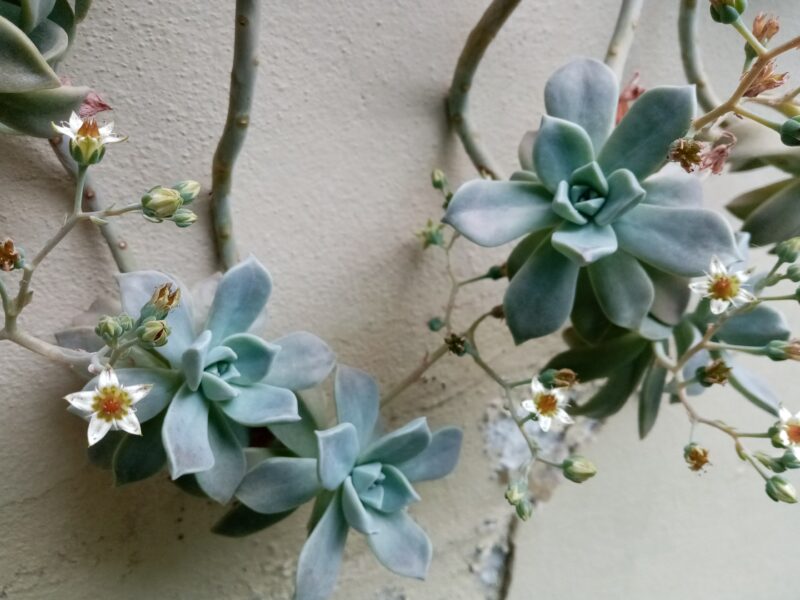
The Ghost Plant, with its enchanting pale blue-green leaves, is a succulent native to Mexico that has gained popularity in desert landscapes and homes. This plant thrives in dry conditions and is considered low-maintenance, making it a favorite among gardeners. Its unique appearance is complemented by star-shaped flowers that bloom in: late spring to summer, adding delightful pops of color. The Ghost Plant is not only aesthetically pleasing but also highlights the diversity of succulents that can survive in arid climates.
Red Pancake (Kalanchoe thyrsiflora)
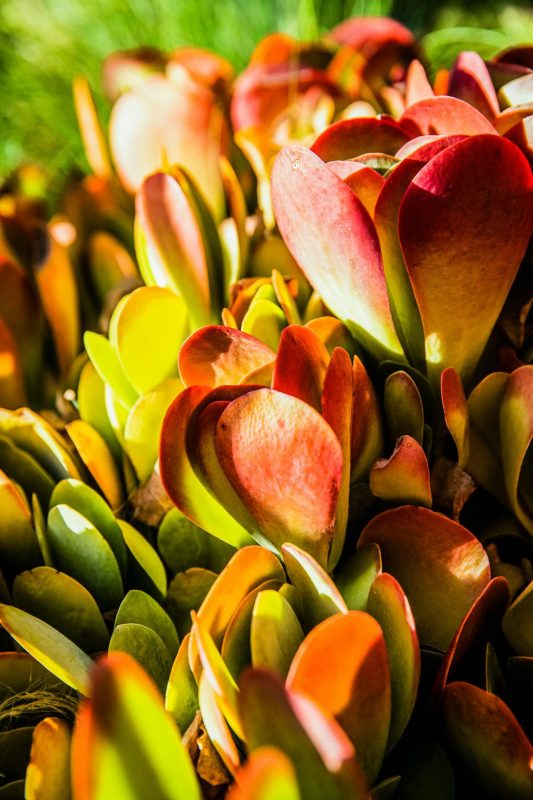
Residing in the succulent family, the Red Pancake—or Kalanchoe thyrsiflora—has gained recognition for its beautifully shaped leaves that form flat, paddle-like structures. In bright sunlight, the leaves can turn a reddish hue, creating a stunning visual effect in the landscape. During late winter to early spring, the plant produces dense clusters of bell-shaped, yellow flowers, attracting pollinators drawn to its colorful display. This unique adaptation enables the Red Pancake not only to resist desiccation but also to flourish in rocky soil, showcasing the ingenuity of desert plants.
Fox Tail Agave (Agave attenuata)

The Fox Tail Agave, beloved for its graceful, arching leaves and striking flower spikes, stands out in the arid landscape. This succulent features smooth, light green leaves that can reach impressive lengths, resembling the tail of a fox, hence its name. Its flowers bloom in a tall spike, producing a wealth of yellow blossoms that attract a variety of pollinators. Unlike many agave species, the Fox Tail Agave does not produce sharp spines, making it a gardener’s choice for landscape beautification. This drought-resistant plant exemplifies nature’s adaptability.
Mexican Feather Grass (Stipa tenuissima)

Mexican Feather Grass adds a delicate touch to the desert with its soft, flowing plumes that sway gracefully in the wind. This perennial grass thrives in dry, well-draining soils and can flourish in a variety of conditions, making it a popular choice for landscaping. The feathery flower heads appear in early summer, providing natural movement and texture to the area. Its resilience in harsh conditions and ability to thrive in minimal water supply highlight the remarkable adaptations of desert grasses.
Tumbleweed

Tumbleweed, the quintessential symbol of the American West, presents a unique survival strategy in desert ecosystems. Its rounded structure allows it to detach from the root system and roll across the landscape, dispersing seeds over a wide area as it travels. This dispersal method ensures the proliferation of its species in sparse desert environments. The Tumbleweed thrives in poor soil conditions and is characterized by its wiry structure, showcasing nature’s ingenuity in seed distribution and survival.
Desert Marigold (Baileya)

The Desert Marigold is a perennial herb that brightens the desert landscape with its cheerful yellow flowers. Blooming almost year-round, this resilient plant is adapted to survive in sandy, nutrient-poor soils. The Desert Marigold supports a variety of pollinators, including bees and butterflies, playing an important role in maintaining ecological balance in the arid environment. Its ability to blossom in harsh conditions and support local wildlife exemplifies the beauty and resilience of desert flora.
Desert Lily (Hesperocallis)

The Desert Lily is a striking plant that emerges beautifully in the spring, showcasing tall stalks crowned with clusters of white, fragrant flowers. This plant thrives in sandy and rocky soil, exhibiting a stunning resilience to drought. The Desert Lily is often seen as a beacon of hope, as its blossoms signify the arrival of seasonal rains. This ephemeral beauty not only captivates observers but also attracts a variety of pollinators, which play a role in its life cycle and ecosystem.
Jumping Cholla (Cylindropuntia fulgida)

The Jumping Cholla is notorious for its barbed spines that easily detach upon contact, leading to its colloquial name. This unique adaptation enables the plant to propagate, as the spines can latch onto animals and be carried to new locations. The Jumping Cholla’s cylindrical stems are covered with dense spines, which serve as a defense against herbivores. In late spring, vibrant yellow flowers bloom, providing sustenance for various insect species. Its defensive mechanisms and unusual growth habits make it a fascinating study in desert adaptations.
Ocotillo (Fouquieria splendens)

The Ocotillo stands out in the desert landscape with its upright, spiny canes that radiate from a central base. Often mistaken for a cactus, this plant is, in fact, a flowering shrub. In spring, the Ocotillo bursts forth with vibrant red flowers that attract hummingbirds and other pollinators. During droughts, it appears leafless, conserving water, but springs back to life with lush green leaves following rainfall. The Ocotillo is an outstanding example of resilience, capable of thriving under extreme conditions while providing vital resources for wildlife.
Yellow Palo Verde (Parkinsonia microphylla)
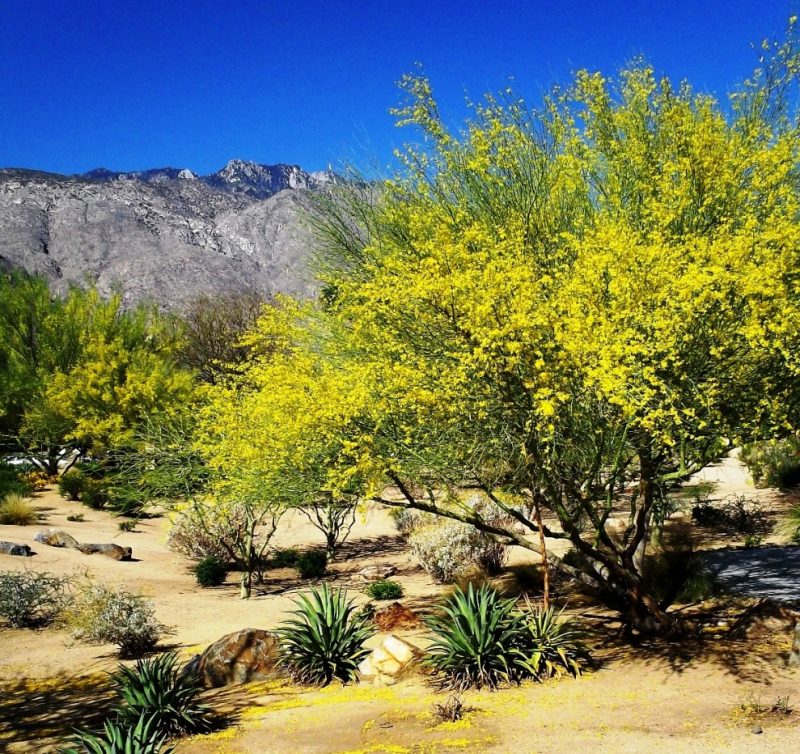
The Yellow Palo Verde is a striking tree that thrives in the Sonoran Desert. Known for its green bark, this tree photosynthesizes through its stems, allowing it to conserve water while still being functional. In late spring, it showcases stunning clusters of bright yellow flowers, which attract pollinators and create a beautiful display in the arid landscape. The Yellow Palo Verde is a keystone species, providing shade and habitat for many desert animals while also maintaining the ecological balance of its environment.
Mojave Aster (Xylorhiza tortifolia)

The Mojave Aster is an endangered perennial plant that paints the desert in hues of purple and blue. Blooming in late spring, the aster’s bright flowers attract a multitude of pollinators, playing an essential role in the desert’s ecosystem. Its adaptability allows it to flourish in sandy soils and harsh conditions, making it a beautiful testament to the resilience of desert flora. This plant is not only vital for its role in pollination but also signifies the delicate balance between beauty and survival in desert environments.
Jade Plant (Crassula ovata)

Commonly housed in gardens and homes around the world, the Jade Plant, or Crassula ovata, originates from the arid regions of South Africa. Its thick, fleshy leaves are adapted to conserve moisture, making it an ideal succulent for arid climates. Jade Plants are often associated with prosperity and good luck, illustrating their cultural significance beyond mere survival. They produce clusters of small pink or white flowers during the blooming season, attracting pollinators and providing a burst of color in the landscape.
Yellow Bells (Tecoma stans)

Yellow Bells, or Tecoma stans, thrive in the peripheries of desert environments, showcasing vibrant yellow, trumpet-shaped flowers that bloom throughout the summer. This hardy shrub loves full sun and can withstand drought, making it a popular choice for landscaping and erosion control. The flowers are not only stunning but also attract hummingbirds and butterflies, playing a critical role in the local ecosystem. Yellow Bells serve as a reminder of the stunning beauty that can emerge in even the harshest conditions.
Desert Palm Trees

Desert palm trees, particularly the California Fan Palm (Washingtonia filifera), bring a touch of tropical elegance to arid landscapes. These palms thrive near water sources, creating lush oases that serve as vital habitats for various desert wildlife. Their towering fronds provide shade and shelter, while the tree’s fruits are a food source for birds and other animals. With their ability to survive extreme temperatures and drought conditions, desert palm trees symbolize resilience and adaptability amidst adversity.
Aloe Vera (Aloe barbadensis)

Aloe Vera is renowned not only for its succulent leaves filled with soothing gel but also for its impressive adaptability in arid environments. This timeless plant thrives in sandy, well-drained soils and is often utilized in skincare products for its healing properties. The leaves grow in a rosette pattern and feature serrated edges. In optimal conditions, Aloe Vera produces spikes of tubular yellow or orange flowers, attracting bees and other pollinators. Beyond its aesthetic and medicinal qualities, Aloe Vera is a symbol of sustainability in desert conditions, showcasing how plants can provide both beauty and utility.
Texas Sage (Leucophyllum frutescens)

Texas Sage, also known as Cenizo, is a standout shrub that flourishes in the hot, dry climates of Texas and northern Mexico. Its silvery-gray leaves reflect sunlight, helping to maintain hydration in drought conditions. During the rainy season, typically in late summer, this hardy plant bursts into vibrant purple blooms, adding a splash of color to the desert landscape. The Texas Sage is not only beautiful but also serves as an important habitat for numerous bird species and insects, contributing to ecological diversity in arid environments.
Bottlebrush (Callistemon)

The Bottlebrush plant is celebrated for its striking flower spikes resembling a traditional bottlebrush. It is especially suited to dry climates, having adapted to thrive with minimal water. In full bloom, the vibrant red or pink cylindrical flowers attract bees, butterflies, and hummingbirds, making it a vital part of the local ecosystem. Bottlebrush trees and shrubs are resilient, often found in transitional desert areas, where they add color and texture to the sometimes stark landscape. Their adaptability and vibrant flowering make them a favorite among gardeners and wildlife alike.
Arizona Poppy Flowers (Kallstroemia grandiflora)

The Arizona Poppy, a charming wildflower, is an emblem of desert flora. With its cheerful yellow blooms sporting a central red spot, it captures the essence of the southwestern landscape. This annual plant typically blossoms in the spring and early summer, showcasing its resilience against harsh sunlight and little water. The Arizona Poppy not only adds beauty to the arid terrain but also provides nourishment to various pollinators, playing a significant role in the desert’s ecosystem.
Marsh Aster (Almutaster pauciflorus)

Marsh Aster is a perennial flowering plant that thrives in the desert’s ephemeral wetlands. Exhibiting delicate purple flowers, this plant typically enhances its environment following seasonal rains. The Marsh Aster is important as it serves as a food source for pollinators and a habitat for various insects. Its resilience to arid conditions and attraction to wildlife contribute to the ecological balance, exemplifying how even in dry regions, life flourishes in various forms.
California Poppy (Eschscholzia californica)

The California Poppy, with its stunning golden orange flowers, is famous both as California’s state flower and for its ability to thrive in sparse environments. This annual plant typically blooms in the spring and can be seen covering vast fields in brilliant sheets of color. The California Poppy has adapted to quickly germinate and grow after rainfall, showcasing its survivability in dry conditions. Its ecological role includes supporting a variety of pollinators, making it an essential component of the desert ecosystem.
Desert Primrose (Oenothera primiveris)
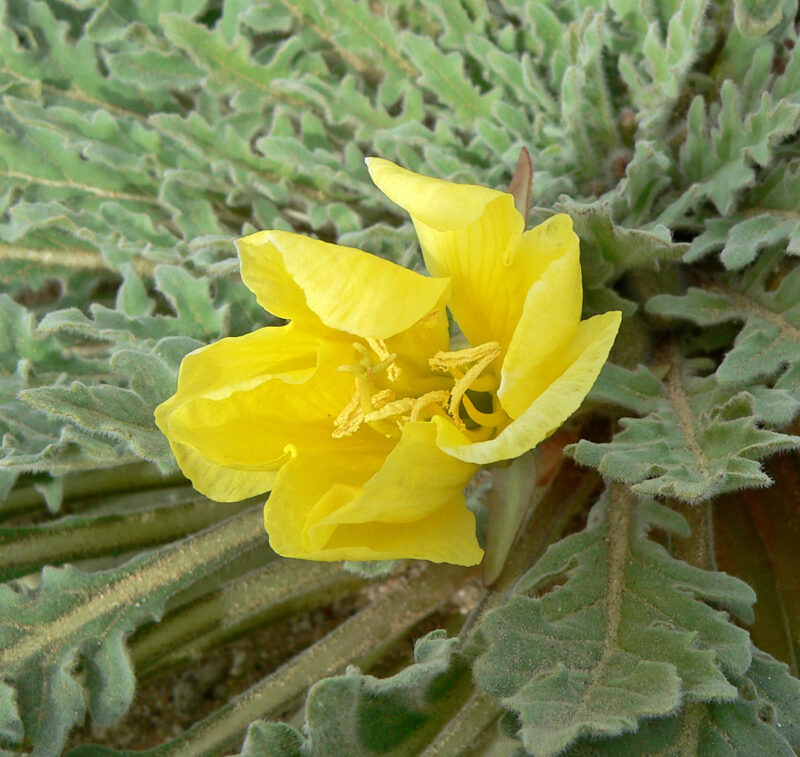
The Desert Primrose is a delicate wildflower known for its fragrant, pale yellow blooms that open in the evening, attracting night pollinators like moths. This perennial plant thrives in the sandy soils of the desert, blooming sporadically during the warmer months. The Desert Primrose’s ability to bloom at night is a remarkable adaptation to desert life, maximizing pollinator interaction while reducing water loss through evaporation. Its ephemeral beauty and role in pollination make it a significant part of the desert’s floral diversity.
Apache Plume (Fallugia paradoxa)

Apache Plume is a stunning shrub characterized by its feathery flower heads that transform into fluffy, white seed tails. This plant flourishes in arid regions and thrives in poor soils, showcasing its resilience. Its flowers, ranging from white to light pink, attract various pollinating insects, playing a crucial role in the desert ecosystem. The Apache Plume’s ability to adapt to challenging environmental conditions makes it an excellent choice for xeriscaping and reinforces the viability of plant life in arid habitats.
Devil’s Claw (Harpagophytum)

Devil’s Claw is a unique and intriguing desert plant known for its distinctive, claw-like seed pods. This sprawling perennial thrives in arid environments and can produce beautiful trumpet-shaped flowers in shades of purple or pink. Traditionally, Native American tribes have utilized the root of Devil’s Claw for its medicinal properties, showcasing its significance beyond landscape aesthetics. The plant’s resilience and versatility underscore the rich pharmacopoeia of desert flora.
Fairy Duster (Calliandra eriophylla)

The Fairy Duster is a small, compact shrub admired for its fluffy, vivid pink flowers that resemble a duster. This plant thrives in the southwestern United States and Mexico, showcasing its stunning blossoms primarily in the spring and summer. The Fairy Duster is pollinator-friendly, attracting bees, butterflies, and hummingbirds, which underscores its ecological importance. Its drought-resistance makes it a popular choice for xeriscape gardens, contributing to both beauty and sustainability.
Desert Mariposa Lily (Calochortus kennedyi)

The Desert Mariposa Lily makes a striking addition to the desert landscape with its exquisite, goblet-shaped flowers that emerge in spring. These flowers bloom primarily in shades of white, yellow, or purple, often boasting intricate markings that lure pollinators. This perennial plant highlights the unique adaptations of desert flora, as it thrives in both sandy and rocky soils. The Desert Mariposa Lily’s ephemeral bloom adds splendor to the arid environments it inhabits, illustrating the beauty of desert life.
Chaste Tree (Vitex agnus-castus)

The Chaste Tree is a robust plant known for its fragrant, lavender flowers that bloom in late summer. It thrives in dry, well-drained soils, showcasing its adaptability to arid climates. Beyond its ornamental beauty, the Chaste Tree is valuable for its medicinal properties, having been used traditionally to address various health issues. Its impressive resilience and multifunctionality make it a notable species in both traditional and contemporary uses of desert plants.
Mulga (Acacia aneura)

Mulga is a hardy tree native to Australia, characterized by its fine, feathery foliage and beautiful yellow flowers that bloom in spring. This drought-tolerant species thrives in sandy soils and provides vital habitat for a wide variety of wildlife. Mulga has deep-root systems that allow it to access water far below the surface, showcasing its incredible adaptation to the desert climate. Its ecological importance and beauty make it an essential component of desert landscapes.
Anacacho Orchid Tree (Bauhinia lunarioides)

The Anacacho Orchid Tree is a captivating sight in the spring, adorned with beautiful white flowers that resemble orchids. This deciduous tree thrives in the warm climate of the southern United States and Mexico, converting what would be a stark environment into a delightful display of color. The Anacacho Orchid Tree is highly resilient, even flourishing in poor soils, making it an ideal choice for xeriscaping. Its exquisite blooms and ability to attract pollinators highlight its ecological significance in the desert.
Cane Cholla (Cylindropuntia spinosior)

The Cane Cholla is a distinctive cactus species that features long, segmented joints. It can produce beautiful yellow or pink flowers during the blooming season, making it a striking addition to desert landscapes. The Cane Cholla’s spines are a defense against herbivores, while its pads serve as a water reservoir during dry spells. This cactus thrives in a variety of soil types, showcasing its adaptability and crucial role in maintaining the desert ecosystem.
Claret Cup Cactus (Echinocereus triglochidiatus)

The Claret Cup Cactus is a stunning species recognized for its vibrant red or magenta flowers that bloom in the spring. This small, spiny cactus is often found on rocky slopes and desert flats, thriving in well-draining soils. Its beautiful blossoms not only enhance the aesthetic of the surrounding landscape but also attract a host of pollinators, from bees to hummingbirds. The Claret Cup Cactus embodies the resilience and diversity of desert flora, playing a pivotal role in its habitat.
Old Man Cactus (Pachycereus schottii)

The Old Man Cactus is a tall, columnar cactus adorned with a luscious tuft of white, hair-like spines that resemble an elderly man’s beard. This species can grow up to 15 feet tall and is known for its impressive height and distinctive appearance. The Old Man Cactus produces beautiful, creamy white flowers that attract nocturnal pollinators. Its resilience to extreme temperatures and minimal water requirements allow it to thrive in arid conditions, serving as a crucial part of the desert ecosystem.
Mexican Fencepost Cactus (Lophocereus marginatus)

The Mexican Fencepost Cactus is characterized by its tall, columnar structure and distinctive vertical ribs. This cactus can reach heights of up to 20 feet and is often seen forming natural fences in its native habitats. In the spring, it can produce beautiful white or pale yellow flowers that bloom at night, attracting nocturnal pollinators. The Mexican Fencepost’s resilience to drought and capacity for moisture retention make it an essential species for desert landscapes, underscoring the ingenuity of desert plants.
Purple Poppy Mallow (Callirhoe involucrata)
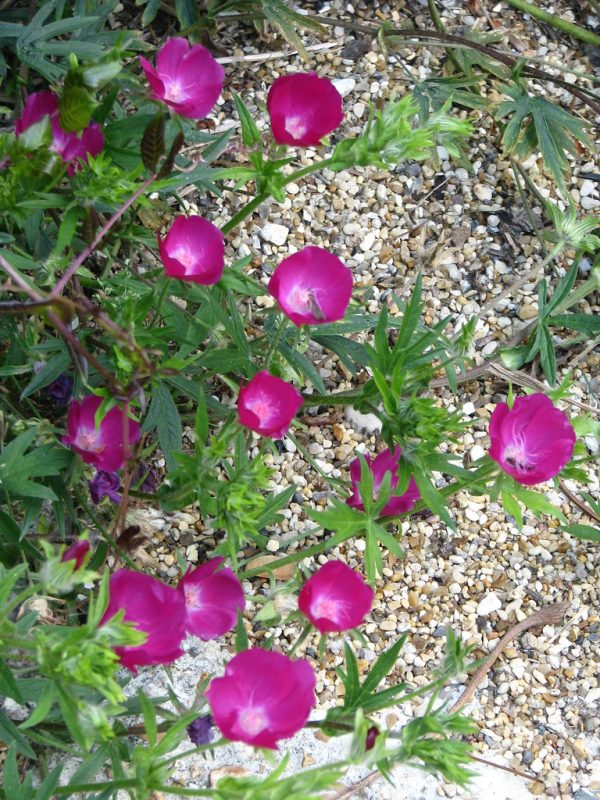
The Purple Poppy Mallow, or winecup, is known for its stunning purple flowers that bloom in profusion throughout the spring and summer. This perennial thrives in sandy or gravelly soils and often forms beautiful ground covers in arid landscapes. The flowers attract bees and butterflies, adding life to the desert environment. Its adaptability and vibrant display of color make the Purple Poppy Mallow a favorite among native plant enthusiasts and a valuable asset to the desert ecosystem.
Purple Sage (Salvia dorii)

The Purple Sage is an aromatic shrub that flourishes in arid environments and showcases delicate purple flowers in late spring. This drought-resistant plant thrives in poor soils and can maintain its foliage even during prolonged dry spells. Beyond its aesthetic appeal, Purple Sage plays a significant role as a nectar source for a variety of pollinators. Its resilience and ecological contributions highlight the importance of native plants in desert ecosystems.
Torchwood Copal (Bursera fagaroides)

Torchwood Copal is a striking tree known for its aromatic resin that has been historically used for incense and traditional medicine. It thrives in the drier parts of the desert, offering not only beauty with its glossy green leaves but also cultural significance. The resin from Torchwood has antimicrobial properties and has been employed in various forms across different cultures. This tree showcases the intersection of beauty and utility in desert flora.
Pencil Tree (Euphorbia tirucalli)

The Pencil Tree, with its tall, slender branches resembling pencils, is a unique species prominently found in arid regions. It has adapted to store water in its stems, allowing it to thrive in extreme conditions. This succulent plant is notable for its milky sap, which can be toxic, serving as a defense mechanism against herbivores. The Pencil Tree highlights the diversity of desert plants with its unusual form and adaptive strategies.
Mexican Lime Cactus (Ferocactus pilosus)

The Mexican Lime Cactus, or Ferocactus pilosus, is a striking round cactus known for its spines that vary in color—from yellow to orange to red. This cactus produces bright yellow flowers that bloom in spring and provides essential nutrition for various desert insects and animals. Its adaptability to poor, rocky soil coupled with its water storage capabilities emphasizes its resilience in the harsh desert environment.
Coral Vine (Antigonon leptopus)

Coral Vine is a vigorous climbing plant known for its showy clusters of pink flowers that bloom throughout the summer. Often found in disturbed sites, Coral Vine thrives in well-drained soils and can rapidly cover fences or trellises, offering a burst of color in arid landscapes. Its sweet nectar attracts a variety of pollinators, enhancing its ecological significance. The Coral Vine serves as both an attractive ornamental plant and an essential food source for wildlife.
Beaked Yucca (Yucca rostrata)

The Beaked Yucca is a striking plant characterized by its long, arching blue-green leaves and distinctive flower spikes that emerge in late spring. This perennial is well-adapted to desert conditions, allowing it to thrive in sandy and rocky soils. The creamy white flowers are not only beautiful but are also vital for attracting pollinators. The Beaked Yucca highlights the diverse adaptations of desert plants, serving as a reminder of the beauty that can emerge from arid environments






